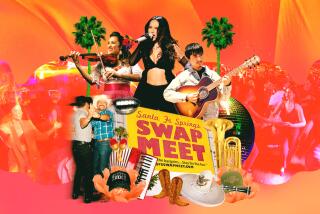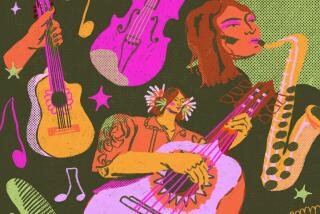Cal State San Marcos Students Take Offbeat Approach to Musical Arts
The first venture by Cal State San Marcos students into the musical fine arts today will not be a fugue by Bach or even a Krenek concerto, but a collection of Andean folk music.
At least half the students in the 16-member Andean Music Ensemble had never played a musical instrument before the beginning of the semester.
Now, they have taken on sikus, a kind of pan pipe, and charangas, a type of miniature guitar.
And, although few of them speak Spanish, all the lyrics will be sung in the native language.
“When I first started, I went home and cried because I got so frustrated and overwhelmed by the problems,” said Shraddha Druliner, who now plays the siku and maracas with the best of them.
“You come out believing in your ability to learn more and different things. It gives you a sense of accomplishment,” Druliner said.
To Donald Funes, professor of fine arts at Cal State San Marcos, the non-European nature of the school’s first musical concert speaks volumes about the university’s focus on non-traditional subjects.
“For Cal State San Marcos to present their first concert and have it be in Spanish and related to this hemisphere, the symbolism speaks loudly,” said Funes, who had previously led an Andean Music Ensemble at Northern Illinois University, but with experienced musicians.
But Funes, himself a classically trained flutist, said the inexperienced music students at Cal State San Marcos have a more rhythmic sense of performing than the trained musicians he taught at NIU.
“They moved more freely and, since they were struggling with the instruments, they got into the feeling of the music more easily,” Funes said. “Written music is only a sign of what the musician plays, and really good musicians sometimes take it too literally.”
Indeed, during the ensemble’s last rehearsal Monday night, the performers’ hips were swaying and their shoulders rocking, quite unlike the straight-back performances of most black-tie recitals.
Performers played their sikus like blowing into so many soda pop bottles while keeping in time with the driving beat of a single antelope-hide drum. Three players strummed charangas, which were originally made with armadillo shells.
“The materials available to people make a difference in the type of instruments they made,” Funes said. Among those materials also were llama toenails, a collection of which are shaken and sound a lot like, well, llama toenails being shaken.
The charangas were adapted from guitars brought over by Spaniards, and since wood was not readily available to the Andean people, the instrument was constructed from the now-endangered armadillo.
The sikus are made of bamboo and are indigenous instruments to the Andeans.
Most of the songs have sad themes such as longing to be home after traveling far away for work, the plight of the exploited and unrequited love.
The rhythm of the songs, however, is upbeat and dance-oriented.
“The rhythm comes from dance, but the text reflects more the state of mind of the performers . . . the mood is kind of melancholy,” said Funes, who said the music was a fusion of African, indigenous American and European rhythms. “It’s an amalgamation of pre-Columbian instruments with European harmony and both African and Indian interest in dance,” Funes said. “When the individuals play their music, they always move.”
Playing the music requires cooperation among all the performers, particularly with the sikus where players alternate notes in playing a tune.
“The reason they alternate is that, at 10,000 feet in the Andes, you’d pass out if you had to play it all,” student Mike Latorre said.
More to Read
Sign up for Essential California
The most important California stories and recommendations in your inbox every morning.
You may occasionally receive promotional content from the Los Angeles Times.










